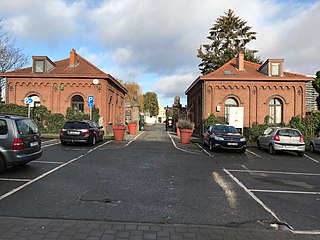
Anderlecht is one of the 19 municipalities of the Brussels-Capital Region, Belgium. Located in the south-western part of the region, it is bordered by the City of Brussels, Forest, Molenbeek-Saint-Jean, and Saint-Gilles, as well as the Flemish municipalities of Dilbeek and Sint-Pieters-Leeuw. In common with all of Brussels' municipalities, it is legally bilingual (French–Dutch).

The City of Brussels is the largest municipality and historical centre of the Brussels-Capital Region, as well as the capital of the Flemish Region and Belgium. The City of Brussels is also the administrative centre of the European Union, as it hosts a number of principal EU institutions in its European Quarter.
The Communist Party of Belgium was a political party in Belgium from 1921 to 1989. The youth wing of KPB/PCB was known as the Communist Youth of Belgium. The party published a newspaper known as Le Drapeau Rouge in French and De Roode Vaan in Dutch.

Julien-Victor Lahaut was a Belgian politician and communist activist was president of the Communist Party of Belgium from 1945 to 1950. An important figure during the German occupation of 1940–44, he became a vocal advocate for the abolition of the Belgian monarchy during the post-war Royal Question. His assassination in August 1950, at the height of the crisis, has often been attributed to Belgian royalists but remains officially unsolved.
The State Security Service (VSSE) (known in Dutch as Staatsveiligheid; French: Sûreté de l'État) is a Belgian intelligence and security agency. Established in 1830, it is the world's oldest intelligence service. The State Security is a civilian agency under the authority of the Ministry of Justice, while the military intelligence agency, the General Information and Security Service, operates under the authority of the Ministry of Defense. The current Administrator-General is Jaak Raes, after his predecessor Alain Winants occupied the position between 2006 and 2014. The VSSE takes part in a number of international intelligence cooperative relationships, such as the Club de Berne and the CTG. It has contacts with over 90 sister services across four continents.

The General Intelligence and Security Service (GISS), known in Dutch as Algemene Dienst Inlichting en Veiligheid (ADIV), and in French as Service Général du Renseignement et de la Sécurité (SGRS) is the Belgian military intelligence service under responsibility of the Minister of Defence. It is one of two Belgian intelligence services, together with the civilian Belgian State Security Service (VSSE).

The Royal Conservatory of Brussels is a historic conservatory in Brussels, Belgium. Starting its activities in 1813, it received its official name in 1832. Providing performing music and drama courses, the institution became renowned partly because of the international reputation of its successive directors such as François-Joseph Fétis, François-Auguste Gevaert, Edgar Tinel, Joseph Jongen and Marcel Poot, but more because it has been attended by many of the top musicians, actors and artists in Belgium such as Arthur Grumiaux, José Van Dam, Sigiswald Kuijken, Josse De Pauw, Luk van Mello and Luk De Konink. Adolphe Sax, inventor of the saxophone, also studied at the Brussels Conservatory.
Albert Raes was a Belgian magistrate and was head of the Belgian Security Services from 1977 until 1990.

The State University of Leuven was a university founded in 1817 in Leuven in Belgium, then part of the United Kingdom of the Netherlands. It was distinct from the Old University of Leuven (1425-1797) and from the Catholic University of Leuven, founded in 1834, which moved from Mechlin to Leuven after the State University had been closed in 1835.

The Belgian National Movement was a major group in the resistance in German-occupied Belgium during World War II with politically centre-right leanings.

Fabrizio Rongione is a Belgian screenwriter, film producer and actor with Italian citizenship.

Marcel-Henri Jaspar, was a Belgian lawyer, politician, and later diplomat. He is best known for his unsuccessful attempt with Camille Huysmans and others to establish an unrecognised Belgian government in London in 1940 during World War II.

Jules-Joseph Guiffrey was a 19th-century French art historian, a member of the Académie des beaux-arts.
The following lists events that happened during 1905 in the Kingdom of Belgium.
Events in the year 1843 in Belgium.
Joseph Cuvelier (1869–1947) was a Belgian archivist and historian.

The Leyniers family (/lɛnɪjɛ/) is a bourgeois family that appeared in Brussels in the 15th century and produced many high-level tapestry makers and dyers, experts in the art of dyeing in subtle shades the woolen threads destined for this trade.
Louis Galesloot (1821–1884) was a Belgian archivist, historian and archaeologist.
Etienne Ugeux (1923–1998) was a Belgian journalist.

Molenbeek-Saint-Jean Cemetery is a cemetery belonging to Molenbeek-Saint-Jean in Brussels, Belgium, where the municipality's inhabitants have the right to be buried. It is located at 539, Chaussée de Gand/Gentsesteenweg, in the west of the municipality. The ensemble extends over 1.5 hectares.











